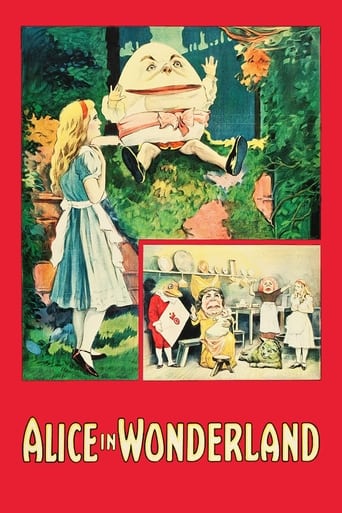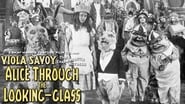Hitchcoc
The film I just watched runs about 51 minutes. Apparently some of the film was lost from the original. It could be chemistry or carelessness. Who knows. So we've lost some scenes. It does make the film a bit disjointed, but if you know your AIW plot, you can still enjoy it. What works here is the costuming. The creation of costumes to match the book characters works very well. Alice is flippant enough to be a bit obnoxious, which is what we want. For what starts out as a gentle little girl, can be quite formidable. I really like the appearance of the mock turtle. The use of close-ups would have helped because we don't get a full appreciation of these characters. Still and all, it was a marvelous film for such an early venture and most of it survived.
Kel Keo
It takes some time getting used to silent movies. There's not a lot of text in this film, so the "over acting" according to today's standards, require some patience of the viewer. However, this is a well thought out version of the story, the scenes are played out with trick effects such as perspective, and remembering the year of production, it's very well made. The only thing that really bothered me was the treatment of animals, both real, such as the garden rabbit, and the (I assume) fake, such as the flamingo and hedgehog. Otherwise, a movie well worth watching, especially if you're a Lewis Carroll/Alice-fan. Time well spent.
johnstonjames
i enjoyed this. but i usually enjoy most approaches on this subject since i find Lewis Carroll irresistible and fascinating history. i also really find silent cinema a lot of fun history too.this was a really cute old silent. i don't think it was great cinema or D.W. Griffith or anything like that. it was actually pretty typical for the time period. aside from the goofy monsters and elaborate costumes. even the silent version of 'Peter Pan' was better cinema than this, and 'Pan' itself is a little pedestrian and unoriginal at times. but like the silent 'Pan' film, this is mostly for laughs and cuteness.this was also not half bad as a adaptation. pretty much all the 'Alice' films only briefly mention the 'Father William' poem, where this film silent presents it in entirety. somewhat ironic that a non talking silent would do that. it also presents a startling image of the Tenniel illustration of Father William doing his somersault.even some young children might find this amusing if they are familiar with the story. but most of today's high tekkie, younger generation, will probably find most of this to be a rickety old monster creep show. i thought it cute, but there were moments that repulsed me and gave me the creepy crawlies. a lot of silent movies can do that.at least it wasn't all dark and scary like the silent version of 'The Bluebird'.this film is a definite must see for 'Alice' fans and silent movie buffs.
Cipher-J
Finding a recorded copy may be hard to do, but not impossible. There are at least two versions that have survived from the original, both lasting approximately forty minutes. The original was a six-reeler, or about an hour long, which may also have included scenes from the "Through the Looking Glass" story. Minimally, what has survived is missing the defining scene early in the story where Alice grows very big and than small, then later the Mad Hatter scene. We know that these scenes were originally included because Grosset & Dunlap published a book version in 1916, illustrated with pictures from this film. This shows that in addition there was also an Oyster, Humpty Dumpty, Tweedledee and Tweedledum, chess room, and a Queen Alice Banquet scene, but whether as part of this film or another is not clear.Viola Savoy was fifteen years old at the time, and a well known child actress for having toured the nation for several years in the road-show version of "The Littlest Rebel." Whether she was the first to perform the role of Virgie in that play, or not, clearly she was the most popular, which fact contributed to her being cast as Alice in this film. As interviewed in 1912 she had been acting since infancy in over one hundred and twenty different productions. After the "Alice" film, however, she appeared in no more than one or two more films before disappearing from the pages of history.Attempting to evaluate the quality of a circa 1915 "photoplay" rather assumes too much. The industry was yet very young. The notion of "close-up" photography was only beginning to be experimented with and hence, more often, the camera just cranked away from a fixed position, rather like someone sitting in the audience of a typical stage play. While plenty of creativity went into the costuming and set design for this film, the camera remains conspicuous for its lack of imagination. Everything is shot from a distance, and as a result, often there is too much going on to keep track of, and the more subtle features cannot be seen. The nuances of facial expression, therefore, have a forced and exaggerated quality which does nothing to flatter the actress. Additionally, the restricted camera position forces her to be upstaged in all too many scenes. Even so, it is a hauntingly captivating film, delightful to see.



